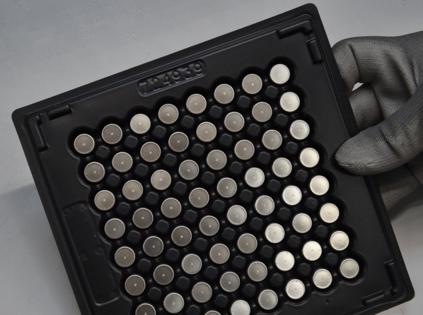Button batteries pose deadly risks to children. Doctors want them to be made safer
Published in Health & Fitness
The round batteries, small as buttons and shiny as coins, are prized for the energy they pack at their size. In households, they have become commonplace, powering remote controls, hearing aids, toys, electric tea lights, wristwatches, greeting cards that play music and other familiar items.
But doctors warn that such "button batteries" can maim and kill. Pop one into your mouth and swallow — as thousands of children do annually — and they can quickly cause devastating injuries.
A growing number of medical associations is pushing for battery manufacturers to head off the threat by making a new product: A button or "coin cell" battery that will not lead to catastrophic injuries when swallowed.
"The only real solution to the battery problem is to make the battery itself safer," said Dr. Toby Litovitz, founder of the National Capital Poison Center.
When button batteries are lodged in the body, their electrical current breaks down water, driving up alkalinity to dangerous levels akin to bleach. Bodily tissues can begin to liquefy. Physicians say serious injury can happen within two hours, sometimes before a parent has even realized that a battery was swallowed.
As button batteries have proliferated in common items, the rate of pediatric emergency visits for battery-related injuries has more than doubled in recent decades, according to a study published in the journal Pediatrics. Some children have ended up relying on tubes to breathe or suffered massive hemorrhaging, doctors said.
"Unfortunately, these batteries cause such severe injuries so rapidly," some of which are impossible for surgeons to repair, said Dr. Kris Jatana, surgical director of clinical outcomes at Nationwide Children's Hospital in Ohio.
Jatana became alarmed by the risks after caring for a 2-year-old child who ended up needing a tracheostomy to breathe. "It was a moment that motivated me to try to see what we could do to prevent these injuries from happening in the first place."
Some battery manufacturers have tried adding bitter coating or saliva-activated dye to tip off parents.
Reese's Law, a federal statute named for a child who died of serious injuries after swallowing a button battery, now requires compartments for such batteries on consumer products to be harder to open and mandates child-resistant packaging for button batteries.
But advocates say more needs to be done. For instance, Litovitz said that harder-to-open packaging would not address the many injuries caused when children swallow batteries left sitting out or discarded. Among those pushing to develop safer batteries is biotech entrepreneur Bryan Laulicht.
"What makes them really great for devices is also what makes them so dangerous when you swallow them," Laulicht said of button batteries. "They're powerful enough to split water ... which spikes the pH up to Drano levels in a matter of minutes."
Doctors began raising alarms about the threat decades ago as more children began to suffer grave injuries. One study found that between 1985 and 2009, the percentage of button battery ingestions that led to serious or deadly injuries had risen more than sixfold.
Litovitz and other researchers pointed to the rising popularity of the 20-millimeter diameter lithium coin cell battery: Their analysis found that 12.6% of children under the age of 6 who ingested button batteries around that size suffered serious complications or death.
They're "just the right size to get stuck in the esophagus of a small child, especially a child younger than four years," Litovitz said in an email. "Further, these lithium coin cells have twice the voltage of other button cells."
Doctors may not immediately recognize and diagnose the problem if no one realized a battery was swallowed, because the symptoms can initially look like those of other childhood ailments.
The problem has worsened over time: From 2010 through 2019, an average of more than 7,000 children and teens went to emergency rooms annually for injuries related to batteries, according to the Pediatrics study. The rate of such emergency visits had doubled compared with the period of 1990 to 2009.
Button batteries were implicated in the bulk of cases where the battery type was known. Researchers have tallied more than 70 deaths from ingesting button batteries over time, but Litovitz said the true number could be far higher because that figure only includes cases documented in medical research or the media or reported to the National Button Battery Ingestion Hotline, which stopped operating six years ago.
At Children's Hospital Los Angeles, doctors see roughly one child a month who has been injured by a button battery, said Helen Arbogast, injury prevention program manager in its division of general pediatric surgery. Children are attracted to shiny things and pick up on the attention that adults pay to electronics, she said.
"Remote controls are really fascinating to them — the buttons, the colors — and part of their natural motor skill development is to learn how to open and close things," Arbogast said.
She stressed that time is critical. "If a parent suspects their child having swallowed a button battery, it's important to get them to a hospital right away."
In Texas, Reese Hamsmith awoke one morning in 2020 congested and wheezing. Her mother, Trista Hamsmith, took the toddler to the pediatrician, who suspected croup. It wasn't until the next day, after a Halloween night when Reese had remained ill, that her mother realized a button battery was missing from their remote control.
Reese underwent emergency surgery, but the damage continued even after the battery had been removed, burning a hole through her esophagus and trachea, her mother said. In the weeks that followed, she underwent more surgeries, sedation and intubation. Less than two months after her injury, Reese died.
She was a year and a half old. After she died, "I held her again, and I promised to her that I would do everything I could that no kid would die this way again," Trista Hamsmith said.
The Lubbock mother started a nonprofit, Reese's Purpose, that successfully pushed for federal legislation that imposed new requirements for battery compartments, childproof packaging and warning labels. Hamsmith was glad to see those rules go into effect, but rued that such protections had not been put in place earlier.
"It shouldn't have to take what we went through" to spur action, she said. "It definitely should not have to take someone like me screaming at the world."
The group is also funding research into a medical device that could detect a swallowed battery without subjecting a child to radiation, which Hamsmith wants to see used whenever a child shows up with possible symptoms. And it worked with Energizer on safety features including a telltale dye that turns blue with saliva.
"The missing ingredient here ... has been the ability to alert the caregiver that something has happened," said Jeffrey Roth, Energizer's global category leader for batteries and lights. "That's really what 'color alert' does — it gives the caregiver notification that a child might have put something in their mouth that they shouldn't have."
Litovitz cautioned, however, that because not all batteries have the blue dye, doctors and parents should not assume that no battery was swallowed if they don't see that color.
Roth said that in recent years, Energizer has spent tens of millions of dollars on research and other efforts surrounding button battery safety. "We believe that one day we will solve this," he said. "But it certainly requires a breakthrough innovation."
Laulicht, cofounder and chief executive of Landsdowne Labs, said his company has been testing an alternative battery with a different kind of casing, intended to shut down inside the body. Tests that involve sandwiching the battery between two pieces of ham do not show the kind of damage inflicted by commercially available button batteries, he said. (Ham is used as a readily available substitute for human gastrointestinal tissue, Laulicht explained.)
One of their challenges has been getting the same level of battery performance with those alterations, Laulicht said. But as a father of young children, "I would rather a battery that only lasted a year on the shelf ... but didn't kill my kid when they swallowed it."
©2024 Los Angeles Times. Visit at latimes.com. Distributed by Tribune Content Agency, LLC.










Comments